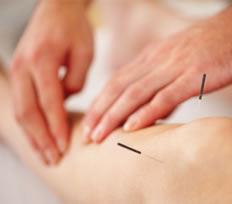 Contemporary Medical Acupuncture is evidence based, precise peripheral nerve stimulation, in which fine solid needles are inserted into various locations in the body, with or without electrical stimuli. The end result is the balancing of abnormal activity in the nervous systems. Needling certain points in the body stimulates the nervous system to release chemicals in the brain, spinal cord and muscles. These chemicals will change the experience of pain, or they will trigger the release of other chemicals and hormones. The improved biochemical balance produced by acupuncture improves the body’s natural healing abilities, and promotes physical and emotional well-being.
Contemporary Medical Acupuncture is evidence based, precise peripheral nerve stimulation, in which fine solid needles are inserted into various locations in the body, with or without electrical stimuli. The end result is the balancing of abnormal activity in the nervous systems. Needling certain points in the body stimulates the nervous system to release chemicals in the brain, spinal cord and muscles. These chemicals will change the experience of pain, or they will trigger the release of other chemicals and hormones. The improved biochemical balance produced by acupuncture improves the body’s natural healing abilities, and promotes physical and emotional well-being.
So how Does Contemporary Medical Acupuncture Work?
Acupuncture produces many of its effects by stimulating nerve receptors in skin and muscle. Various substances are released that cause an increase of local blood flow that encourages tissue healing. Acupuncture helps to reduce pain locally where the needles are inserted and throughout the body. Acupuncture has a calming effect and produces well-being. It works by inactivating myofascial trigger points. It has been found to have positive effects on the brain. The effects of acupuncture accumulate when repeated.

